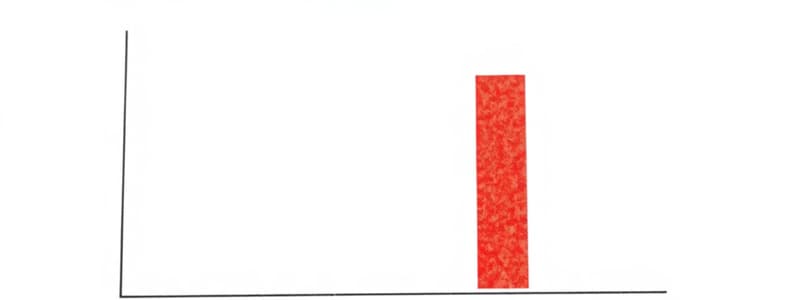Podcast
Questions and Answers
What is the primary goal of a researcher when analyzing a sample?
What is the primary goal of a researcher when analyzing a sample?
- To eliminate all random variability
- To prove a specific hypothesis
- To compute the exact statistics for the sample
- To generalize findings to a larger population (correct)
What term is used to describe the corresponding values of a population?
What term is used to describe the corresponding values of a population?
- Means
- Sample values
- Parameters (correct)
- Statistics
What does sampling error refer to?
What does sampling error refer to?
- A systematic issue in data collection
- An error in the methodology used
- The variation in statistics from one sample to another (correct)
- The mistakes made during sample selection
What primarily causes Type II errors in research design?
What primarily causes Type II errors in research design?
If a sample shows a statistical relationship, what can be concluded about the population?
If a sample shows a statistical relationship, what can be concluded about the population?
How can the chance of a Type I error be reduced?
How can the chance of a Type I error be reduced?
What implication does the presence of random variability have on statistical conclusions?
What implication does the presence of random variability have on statistical conclusions?
Why might the mean number of depressive symptoms differ across various samples?
Why might the mean number of depressive symptoms differ across various samples?
What is the implication of lowering αlpha to reduce Type I errors?
What is the implication of lowering αlpha to reduce Type I errors?
What is the relationship between sample statistics and population parameters?
What is the relationship between sample statistics and population parameters?
Why do researchers consider replicating studies important?
Why do researchers consider replicating studies important?
What is the commonly accepted significance level among researchers to manage errors?
What is the commonly accepted significance level among researchers to manage errors?
What is the purpose of null hypothesis testing?
What is the purpose of null hypothesis testing?
What does the null hypothesis (H0) represent?
What does the null hypothesis (H0) represent?
What is the significance level often set to in null hypothesis testing?
What is the significance level often set to in null hypothesis testing?
What happens if the p value is lower than your alpha level?
What happens if the p value is lower than your alpha level?
What is a Type I error?
What is a Type I error?
When is a result considered statistically significant?
When is a result considered statistically significant?
What does a Type II error signify?
What does a Type II error signify?
What is the logical first step in null hypothesis testing?
What is the logical first step in null hypothesis testing?
What questions did Mehl and his colleagues investigate regarding talkativeness? (refer to reading)
What questions did Mehl and his colleagues investigate regarding talkativeness? (refer to reading)
If a researcher states 'fail to reject the null hypothesis', what does it indicate?
If a researcher states 'fail to reject the null hypothesis', what does it indicate?
Flashcards
Sample Statistic
Sample Statistic
A numerical value calculated from a sample of data.
Population Parameter
Population Parameter
A numerical value calculated using the entire population.
Sampling Error
Sampling Error
Random variation in a statistic from sample to sample.
Statistical Relationship (Sample)
Statistical Relationship (Sample)
Signup and view all the flashcards
Statistical Relationship (Population)
Statistical Relationship (Population)
Signup and view all the flashcards
Inference
Inference
Signup and view all the flashcards
Imperfect Estimate
Imperfect Estimate
Signup and view all the flashcards
Type II Error
Type II Error
Signup and view all the flashcards
Statistical Power
Statistical Power
Signup and view all the flashcards
Why is α = 0.05?
Why is α = 0.05?
Signup and view all the flashcards
Replication and Errors
Replication and Errors
Signup and view all the flashcards
Interpreting Studies
Interpreting Studies
Signup and view all the flashcards
Null Hypothesis
Null Hypothesis
Signup and view all the flashcards
Alternative Hypothesis
Alternative Hypothesis
Signup and view all the flashcards
P-value
P-value
Signup and view all the flashcards
Alpha (α)
Alpha (α)
Signup and view all the flashcards
Statistical Significance
Statistical Significance
Signup and view all the flashcards
Null Hypothesis Testing Logic
Null Hypothesis Testing Logic
Signup and view all the flashcards
Study Notes
Null Hypothesis Testing
- Researchers aim to draw conclusions about populations based on samples.
- Sample statistics are estimates of population parameters.
- Sampling error refers to random variability in a statistic from sample to sample.
- Statistical relationships in a sample may or may not reflect population relationships.
- The null hypothesis (H₀) posits no relationship in the population.
- The alternative hypothesis (H₁) posits a relationship in the population.
Logic of Null Hypothesis Testing
- Assume the null hypothesis is true.
- Assess the likelihood of the sample relationship if H₀ were true.
- Reject H₀ if the sample relationship is highly unlikely.
- Retain H₀ if the sample relationship is not highly unlikely.
- p-value represents the likelihood of the sample result under H₀.
- A low p-value suggests the sample result is unlikely under H₀, leading to rejection.
- α (alpha) is the criterion for rejecting H₀, usually set to 0.05.
- A statistically significant result has a p-value ≤ α.
Type I and Type II Errors
- Type I error: Rejecting H₀ when it's true. This means concluding there's a relationship when none exists.
- Occurs due to sampling error.
- Probability of Type I error is α.
- Type II error: Retaining H₀ when it's false. This means concluding there's no relationship when one does exist.
- Often due to low statistical power (insufficient sample size).
- Researchers must balance the risk of both types of errors.
- Lowering the risk of one type increases the risk of another.
- α=0.05 is a common compromise.
- Replication is crucial to increase confidence in results.
Studying That Suits You
Use AI to generate personalized quizzes and flashcards to suit your learning preferences.




